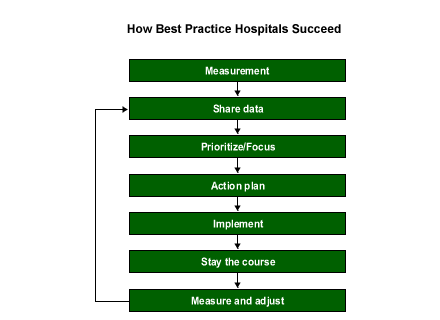Previous articles in this series have examined what separates best-practice hospitals (those scoring in the 80th percentile of Gallup's healthcare patient satisfaction database) from average hospitals (those scoring in the 50th percentile of the database) in each of the four service areas that Gallup measures (namely, emergency departments, inpatient services, outpatient surgery facilities, and outpatient test and treatment facilities). But examining the differences between "average" and "best-practice" groups raises two fundamental questions: How did the best-practice hospitals become so successful in terms of patient satisfaction in the first place, and how can the average hospitals work toward best-practice status?
As a Gallup healthcare consultant for the past 12 years, I have observed countless average and above-average hospital departments and units. These observations, together with the 50th percentile-80th percentile comparison we've examined over the last few weeks, reveal several keys to success.

Step One: Measurement
Hospitals can't know where they want to go until they know where they are. They must have an ongoing, valid, and reliable system of measurement for determining how well they are satisfying their patients.
The improvement process begins with a baseline of performance. The best managers know how to assimilate this baseline satisfaction measurement with other measurement systems. For instance, a best-practice emergency department director does not simply know that her patients are dissatisfied with waiting times. She also knows the current average wait times for various steps in the process at different times of day. Good lab managers know the average time it takes from the submission of an order to receipt of results by the ordering physician.
Step Two: Share Data
It is not enough for the manager alone to be familiar with patient satisfaction results. All employees must know their current level of performance. One CEO that I met walked the halls of his hospital and asked the staff members how they were doing on patient satisfaction. The most frequent responses were "OK" or "I don't know." Managers must post patient satisfaction results for the entire staff to see and hold ongoing discussions on performance and expectations for improving scores.
Step Three: Prioritization/Focus
Hospital employees are busy. Nurses, for example, deal with increased patient volumes and staffing shortages at the same time. Developing 10 or 20 separate action plans for different areas of improvement is not feasible, so those areas must be prioritized and those that have the most impact must receive the lion's share of focus.
Step Four: Action Plan
Stepping on a scale every morning does not constitute a diet. The same goes for measuring patient satisfaction. One must measure and take action to achieve results. The actions taken to improve patient satisfaction must be specific, measurable, actionable, and timely. Simply saying "we will do a better job" is not enough.
Staff members, as well as managers, should prioritize and develop action plans. Some behaviors that need to be implemented may seem simple, such as asking patients if they need anything else before leaving the room. However, if such scripts, protocols, and procedures are imposed from above, rather than developed by staff members at the workgroup level, employees may be less likely to follow them.
Step Five: Implement
Planning has no impact if it does not result in action. I once worked with a nursing manager with great action plans who complained that the plans were never successfully implemented. A quick review of the situation revealed the fatal flaw -- the manager was responsible for implementing all the plans. Implementation is a task for the entire workgroup. If not everyone buys in and participates, the action plans are doomed to failure.
Step Six: Stay the Course
Improvement that lasts for one week, one month, or even one quarter does not constitute true success. Success is long-term, sustainable improvement. Once they establish their priorities, workgroups need to maintain focus on them. A common factor in failures I have observed is tendency of workgroups to change priorities each time they receive new patient satisfaction results. Hence, no action plan is ever seen through to completion. Workgroups should pick their top priorities, maintain focus until they achieve success, and only then identify the next area for improvement.
Step Seven: Measure and Adjust
How do workgroups know that they've succeeded? They must have specific, measurable objectives and ongoing measurement to determine if they are achieving these objectives over time. Continuous patient satisfaction measurement provides trended data showing change over time, which allows workgroups to modify their strategies as needed.